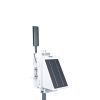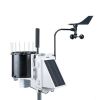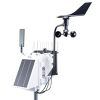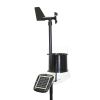Spectrum WatchDog 3220 Wireless Rain Stations
Features
- Integrated solar power system for reliable power
- Optional Wi-Fi or cellular modem for wireless communications
- Integrated data logger holds 18 months of data at a 15-minute recording interval
- Free ground shipping
- Expedited repair and warranty service
- Lifetime technical support
- More
Overview
The fully integrated WatchDog 3220 Wireless Rain Station measures rainfall, temperature, and humidity, recording and communicating the data to the cloud using its internal modem.
Benefits
- Integrated Solar Power system for reliable power.
- Integrated Modem/Radio for reliable communications: available with a choice of cellular modems or other radios.
- Integrated Data Logger protects your data. Holds over 18 months of data at a 15-minute recording interval. Data can be transferred to a USB flash drive.
- Easy to install - be running in minutes. Mounts to a 1.25 inch mast. U-bolts included.
- Bluetooth connectivity to your Apple or Android smartphone running the free WatchDog Mobile App speeds setup and displays current conditions.
- Sends data to the SpecConnect Cloud Solution - View current conditions or historical data using a broad selection of analytical reports from anywhere in the world.
- Receive alerts via automated phone call, text message, and/or email immediately when temperature crosses your selected threshold - no waiting for the next scheduled upload.
- Customizable with plug-in sensors to meet your needs
- Receive the latest changes with over-the-air updates (also available via a USB flash drive).
- Durable enclosure provides moisture, corrosion, and UV protection for increased reliability in harsh environments.
- Designed and manufactured in the USA to provide the quality data you can rely on.
- External Communication: Cellular, USB, Bluetooth, RS232
- External Sensor Ports: 1 x 2.5mm stereo jack (0 to 3.0VDC analog input)
- Data Capacity: 30,000 data intervals can be stored on the unit before the oldest record is overwritten by the newest data (312 days at 15 minute intervals).
- Dimensions (HxLxW): 12 x 19.5 x 11.25 in (30.5 x 49.5 x 28.6 cm). (Without 7.25 in (18.4 cm) antenna)
- Weight: 9.9 lbs. (4.5 kg)
- Power Source: 3.5W solar panel, Rechargeable 6V/4.5AH SLA battery, optional AC/DC power adapter.
- Battery Life: 14 days minimum with no solar power.
- LED: 3-color (Red, Amber, Green)
- Operating Temperature Range: -22° to 130°F (-30° to 55°C)
In The News
Monitoring Mariculture in the Gulf of Alaska
The mariculture industry in the Gulf of Alaska has been steadily growing in recent years, guided by ongoing research to help refine farm location and cultivation practices. A subset of aquaculture, mariculture focuses on rearing organisms in the open ocean. In Alaska, finfish farming is illegal, so most farms cultivate kelp, oysters, or a combination of the two. These small, locally operated farms started popping up in the Gulf of Alaska in the early 1990s, when shellfish farming first became legal. Kelp farming did not begin to catch on in the state until 2016. Many of the coastal areas that have grown interested in mariculture are historically commercial fishing communities.
Read MoreSupplying Seattle’s Drinking Water: Using Data Buoys to Monitor the Cedar River Municipal Watershed
Providing clean, safe, and reliable drinking water for the 1.6 million people in the greater Seattle area is a top priority for Seattle Public Utilities (SPU). With limited water supplies, SPU dedicates considerable resources to maintain its watersheds and mountain reservoirs. About 70 percent of Seattle Water comes from the Cedar River Municipal Watershed , and the other 30 percent comes from the South Fork Tolt River Watershed . [caption id="attachment_39574" align="alignnone" width="940"] Data buoy in Chester Morse Lake . (Credit: Kevin Johnson / Seattle Public Utilities) [/caption] Jamie Thompson, a fisheries biologist at SPU, monitors aquatic ecosystems centered on fish listed under the U.S. Endangered Species Act (ESA).
Read MoreData-Driven Advocacy on the Lower Deschutes River
Like many freshwater environments, the Deschutes River in Oregon is under pressure from development, pollution, and climate change. Many rivers, streams and lakes in the Deschutes Basin do not meet Oregon water quality standards –where state water quality monitoring assesses levels of bacteria, pH, dissolved oxygen, temperature, and fine sediment. Hannah Camel is the Water Quality Coordinator for the Deschutes River Alliance (DRA), a non-profit organization that focuses on the health of the lower 100 miles of the Deschutes River–the area most affected by human intervention. As a data-driven organization, the DRA has benefited from the installation of two NexSens X2 data loggers.
Read More



























